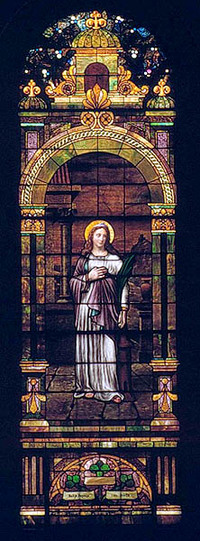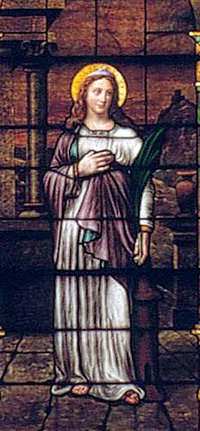Window
Building Name: St. Paul the Apostle Church (formerly St. Joseph Church)Studio Name: Ford Brothers Glass Company
City: Calumet
Window Shape: 3 (arched)
Date of Window: 1906
Subject/Title of Window: St. Barbara
Brief Description of Subject: St. Barbara is another important figure for laborers in general and miners in particular because she is the patron saint of miners. Barbara is also patron to architects, builders, dying, fire prevention, founders, prisoners, and stonemasons. Barbara's origins, although generally set in the 4th century, are not a subject of agreement among scholars. According to David Farmer's Oxford Dictionary of Saints, Barbara's existence is doubtful, due to the fact that there is no evidence of a saint's cult for her. "Her Greek Acts, notoriously unhistorical, were not written until the 7th century; even more suspicious, Nicomedia, Heliopolis, Tuscany, and Rome all claimed to be the place of her death. This uncertainty did not prevent her cult [from] becoming very popular in the later Middle Ages, especially in France." Sandoval likewise describes her story as "religious fiction," while Lanzi states that her cult "was established and widespread from very early times, but we have only vague information about her". Literary scholar Karen Winstead describes Barbara as one in a series of virgin martyrs in hagiography and material culture that is "remarkably homogenous" in their physical traits and in their manner of martyrdom. Such figures meet untimely, violent deaths—boiling, burning, dismemberment and so on—in the act of preserving their chastity. In their often serene representations in art, the only way to distinguish one of these martyrs, Winstead notes, is that she typically carries or wears the symbol of her suffering—such as a tooth, (St. Apollonia), her eyes (St. Lucy), a wheel (St. Katherine). Barbara's legend tells of the girl and her pagan father named Dioscorus, who locks Barbara in a tower to keep her out of the view of men. In her father's absence, Barbara is converted to Christianity. She moves into a bath-house her father is building, asking the workmen to add a third window in honor of the Holy Trinity. Discovering her conversion, Dioscorus turns the girl over to the authorities. Barbara is tortured and ultimately sentenced to death at the hand of her father. After slaying Barbara, Dioscorus is killed himself by a bolt of lightning. Barbara's association with thunder established a link to explosions, and therefore her invocation as a protector of miners, firemen, oil-workers artillerymen, and soldiers, among other dangerous professions. In the window here, we see Barbara with two of her principal attributes that often identify her, a tower and a peacock feather. The tower recalls her place of imprisonment and the windows she had built for the trinity—in some representations three windows may be visible. The feather recalls her suffering under torture in her legend, when the rods that were being used to beat her miraculously turned to peacock feathers.
Inscriptions: Mozje Zupnije Isv. Jozeta
Condition of Window: Good
Height: 15'6"
Width: 5'
Type of Glass and Technique: Antique or Cathedral Glass, Enamel Paint, Lead Came
St. Barbara
St. Barbara close-up
The MSGC is a constantly evolving database. Not all the data that has been collected by volunteers has been sorted and entered. Not every building has been completely documented.
All images in the Index are either born-digital photographs of windows or buildings or are scans of slides, prints, or other published sources. These images have been provided by volunteers and the quality of the material varies widely.
If you have any questions, additions or corrections, or think you can provide better images and are willing to share them, please contact donald20@msu.edu




